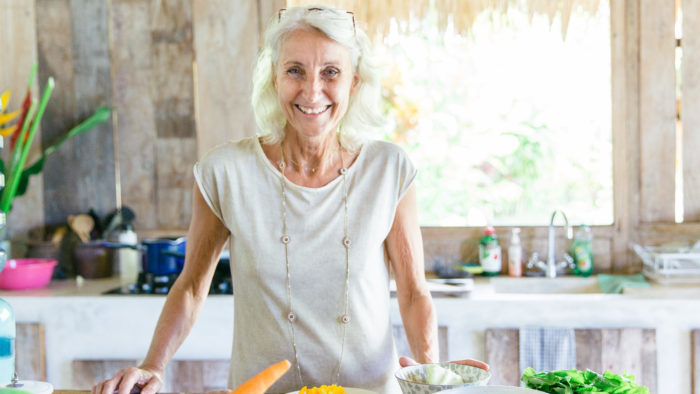Austrian Chef Daniela Wolff discovered Ayurvedic cooking when she visited India to learn Yoga. Providentially, at Rishikesh she was given a flier on Ayurvedic cooking which took her to South India and the wisdom of Ayurveda.
In this interview with CSP, she emphasises on local and seasonal produce and on the benefits of making sure that from earth to hearth the journey of food is no more than two days.
How did you first connect with Ayurveda?
On a yoga journey to Rishikesh, I got a notice of a Ayurveda conference which was organized by the Punarnava trust. I went there, all by myself, not knowing anybody, it was a real adventure. Despite it being freezing cold in Rishikesh in the month of February, I was in full bliss during the conference as the speakers and the program was really inspiring.
I decided to go for a Panchakarma treatment to Coimbatore a few months later and the bliss continued. The difference from the other several places I had visited so far was the heart felt friendliness and compassion of all the people connected to the extended Vaidyagrama family. I also appreciated that there was no wellness bling bling implemented for the comfort of Western patients. The simplicity matched perfectly with the comfort of the rooms, the green and quiet surrounding.

What aspects of Ayurveda cooking and diet interest you?
The most important two things in an Ayurvedic diet for me are home cooking and the use of spices. With two tools you have the perfect base to add other principles on top. Like choosing high quality food from your region and season, cooking the simple way, eating warm and freshly cooked food at the right time (lunch as the main meal per day), eating the right quantity of food, integrating all six tastes into your meal, eating in a relaxed state of body and mind, with awareness and joy.
Can a strict Ayurveda diet also be tasty and appealing?
Of course. Taste is generated by prana rich ingredients, which means freshly sourced and cooked. We know the trend of farm-to-table or garden-to-table meals. From harvesting to eating there can be only a few hours or max of one or two days. If you add high quality spices, the meal gets very appealing.
Are spices used differently in Ayurveda compared to how they are normally used?
I would say yes. The combination of chosen spices not only promotes flavour but also enables an additional effect: It kindles the digestive fire and increases the appetite. It acts more or less like medicine and can help to digest ama, the undigested leftovers from malabsorption due to overeating, untimely eating, western medicines or pollution. This concept is less known or incorporated in other food cultures. There are powerful herbal remedies for the kitchen in traditional European cuisines which can be compared. Each culture used the available resources and nowadays, spices can be used everywhere in the world. A great benefit.

How can eating an Ayurveda based diet be useful even outside India?
The principles of Ayurvedic eating can be adapted all around the world and are not stitched to India only. It is a very open system. Ayurveda says you should eat the food which is growing in your region. So the Mediterranean cuisine is Ayurvedic to the people living around the Mediterranean Sea. Mexican tacos are Ayurvedic to the Mexicans, as long as they prepare them according to their tradition. You can adapt this to most food cultures, maybe the least to the American Standard Diet. That is too far disconnected from nature meanwhile.
How can we become more conscious about where we source the food from?
Key are the farmers markets and smaller organic shops all around the world. There we are fully connected to region and season and heartful suppliers. Most of the farmers are producing in small quantities and use less or no chemicals on their fields. In a busy world, many of them also offer delivery services, which makes the logistics of purchasing healthy food much easier. If you buy at farmers markets or organic shops, most of the time a whole network of likeminded suppliers will show up in front of you with other products for a healthy lifestyle.
What is the interest in Ayurveda and Yoga in Austria?
There is a vibrant community of Yoga and Ayurveda in Austria and well connected with Germany. You can find Yoga studios even in smaller villages. People here are open minded and longing for the wisdom of yogic scriptures. Alongside that, a smaller but growing Ayurveda community is around. People are looking for answers when they start getting the lifestyle symptoms of fatigue, low energy, slow digestion, constipation, skin disorders etc.. Practical guidelines for a busy lifestyle are appreciated. The complex system of a diet by constitution is not easy to transmit, but basic guidelines which are valid for ALL constitutions are well received.
How were meal times in Vaidyagram? Are there any memories you cherish?
The meals at Vaidyagram are very simple, mildly spiced and exactly timed to the circadian rhythm of nature. They offer a smaller breakfast in typical South Indian way with idli, dosa, chutney kanji, mungbean soup. The main meal at lunchtime contains different kinds of grains, vegetables, dal and an exciting buttermilk soup which is freshly prepared every day. Some fruits in the afternoon and a small dinner finish the day. Almost no sweets (fruits and once in a while prasad after a puja), that's it. I never missed anything.





